| SUMMARY OF: | A Sunset Review of the Department of Commerce, Community, and Economic Development, Board of Certified Direct-Entry Midwives, September 11, 2006. |
Purpose of the Report
In accordance with Title 24 and Title 44 of the Alaska Statutes (sunset legislation), we have reviewed the activities of the Board of Certified Direct-Entry Midwives (board). As required by state law, the legislative committees of reference shall consider this report during the legislative oversight process to determine whether the board should be reestablished. Currently, AS 08.03.010(c)(8) states that the board will terminate on June 30, 2007, and will have one year from that date to conclude its administrative operations.
Report Conclusions
In our opinion, the termination date for the Board of Certified Direct-Entry Midwives should be extended. The board is operating in the public interest by promoting the competence and integrity of those who hold themselves out to the public as qualified and competent direct entry midwives.
The board proposes changes to regulations to improve its effectiveness and to ensure that midwives and apprentice midwives are licensed in the State of Alaska.
Alaska Statute 08.03.010(c)(8) requires that the Board of Certified Direct-Entry Midwives be terminated on June 30, 2007. Under AS 08.03.020, the board has a one-year period to administratively conclude its affairs. We recommend that the legislature extend the board’s termination date until June 30, 2015.
Analysis of Public Need
Since inception of the board in 1992, biennial licensing fees for this occupation have increased significantly. During this audit review period, the biennial licensing fees increased 55% to $2,088 and are not expected to decease for the next licensing period.
Currently, the licensing fees established for this board are the highest of any other licensed profession. The fees are high because of the limited number of licensed midwives and unpredictable legal and investigative costs.
High licensing fees may, to some individuals, represent a barrier of entry into a profession. However, licensing data for this board shows that fees have not stopped the growth in the number of individuals being licensed as midwives or entering into the apprenticeship program. As long as licensing fees remain high, the board should monitor for any substantial negative impact the fees have on the number of direct-entry midwives practicing in Alaska.

